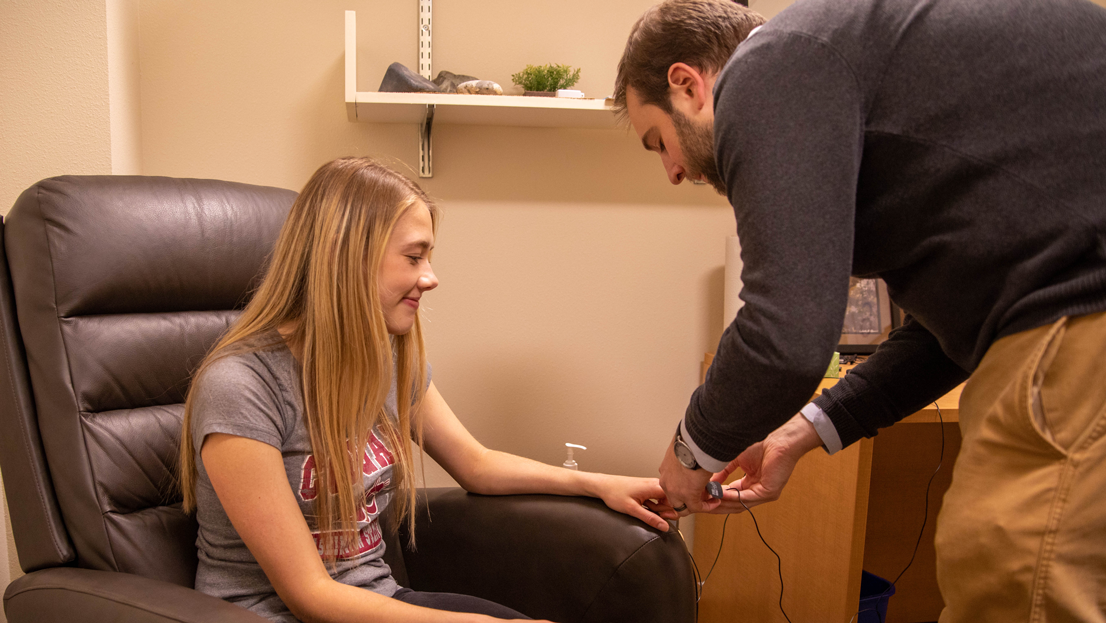
Biofeedback
College can be stressful. Seeing how your mind and body respond to that stress through biofeedback can help you make positive changes that reduce your overall stress and improve your health.
With biofeedback, you are connected to electrical sensors that measure various bodily processes such as heart rate, skin temperature, and muscle tension. The information from the sensors is displayed on a computer screen, giving you real-time information (feedback) about your body (bio).
A biofeedback counselor helps you understand the feedback, coaches you in how to make small changes in your body to reduce stress, and works with you to develop a plan for practicing these skills on your own.
Over time, the skills you learn can help you reduce your overall stress, increase feelings of calm and control, and improve your academic performance.
How Biofeedback Works
Biofeedback sensors detect physiological activity. The placement of the sensors varies depending on the symptoms you are working on and the type(s) of biofeedback used. Sensors are attached with easily removable materials and will not hurt to attach or remove.
- Heart rate: A sensor is either clipped to your earlobe or attached to a finger with a Velcro band to detect your pulse and measure heart rate and heart rate variability.
- Temperature: A thin wire with a thermometer at the end is gently taped to one of your fingers to detect changes in hand temperature.
- Muscle contraction: Pre-gelled, disposable sensors are placed on the skin over muscles in your forehead, jaw, neck, and/or arms to monitor tension.
- Sweat gland activity: A sensor is attached to a finger with a Velcro band to measure the amount of perspiration on your skin.
Biofeedback is generally safe but might not be appropriate for everyone. If you have questions or concerns about biofeedback, be sure to discuss it with your doctor first.
Why biofeedback?
Biofeedback gives you real-time data on your body’s response to stressors and relaxation skills designed to reduce those stressors. It’s a helpful way to see how you can proactively manage symptoms of stress and anxiety with simple techniques you can use anywhere.
Biofeedback can help people with a variety of stress- and anxiety-related concerns. It may be right for you if:
- You experience muscle tension when stressed or anxious (e.g., clenching your jaw, neck/shoulder tension)
- You get headaches when stressed
- You experience increased heart rate when stressed or anxious
- You have difficulty falling asleep because you can’t get your mind/body to relax
This is not a comprehensive list; these are common concerns among people seeking biofeedback, but not the only ones we see. Please also note that there may be medical reasons for these symptoms.
What to Expect
Biofeedback appointments typically last 40-50 minutes and involve one-on-one work with a mental health professional. You will be asked to attach sensors to various points on your body to obtain the feedback.
- At the beginning of the appointment, your counselor will talk with you about the symptoms you want to work on and then recommend one or more types of biofeedback and relaxation skills.
- The counselor will explain how the sensors work before attaching them. Once the sensors are attached, you will see biofeedback data on a computer screen. As your counselor teaches you a relaxation skill and coaches you in how to practice it, the sensors will detect changes in your body, increasing your awareness of how your body responds to the skill.
- Near the end of the appointment, your counselor will work with you to develop a plan for additional practice on the techniques you learned.
Start Biofeedback
At your initial consultation, your counselor may recommend biofeedback on its own or in conjunction with other therapies. If you are specifically interested in biofeedback, be sure to mention that to your counselor.
Make an appointment to meet with a mental health professional for an initial consultation to get started.